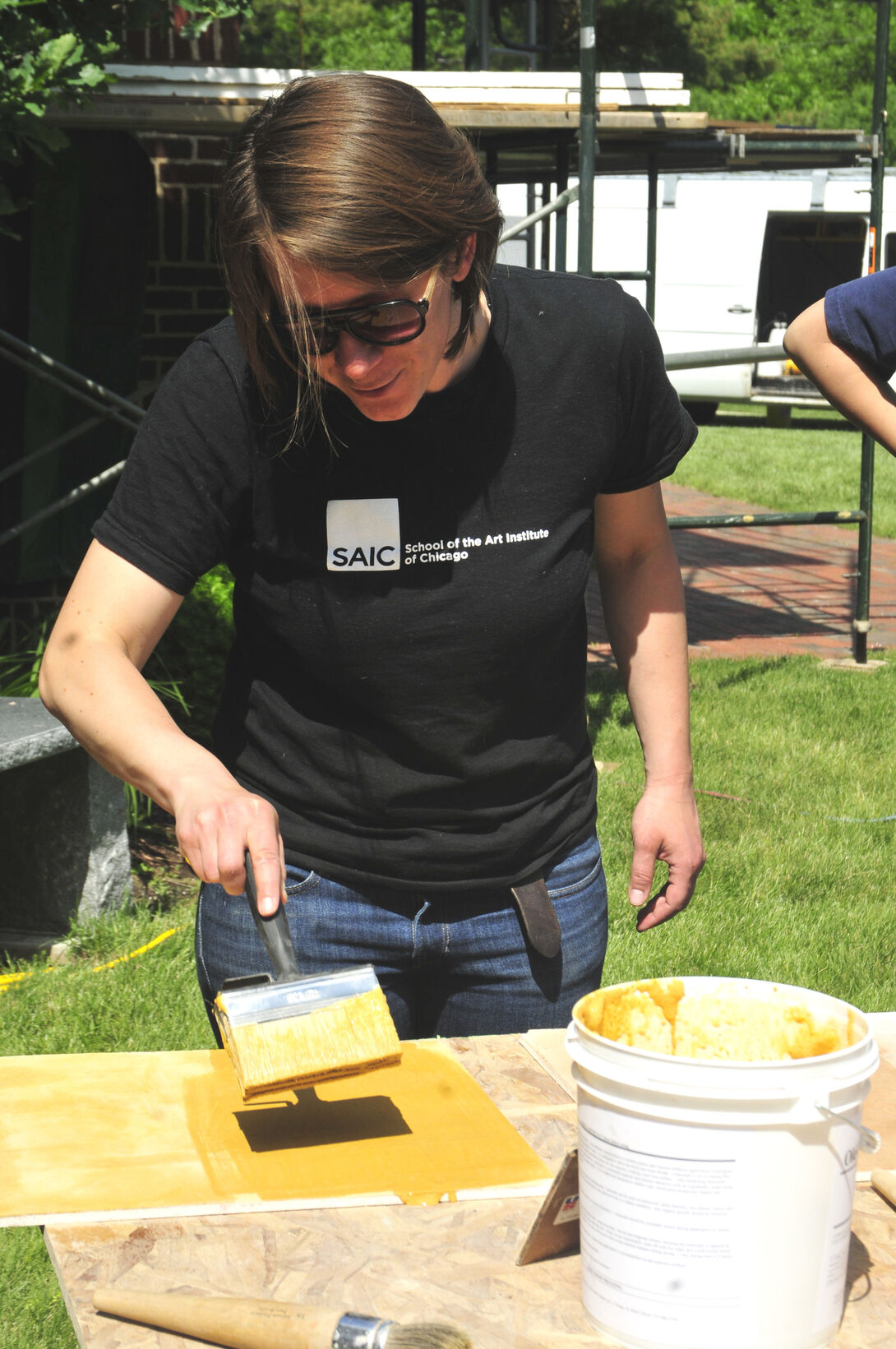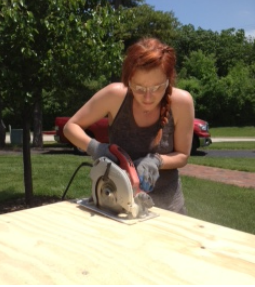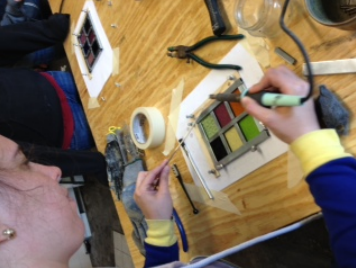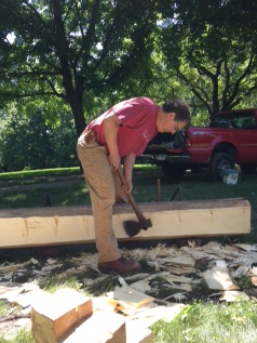
Excerpts from Kelly Humrichouser's Restoration Methods Journal

Tuesday, May 28: The first day of class! We spent the morning at a Oak Brook village walk-through of the basement wall of the school house to see how the bidding process works. It was interesting to see how professionals bidding against each other conduct themselves during the process, what notes they take, and how the village and the historical society partner to cover the building's restoration expenses. Facing my fear of heights by climbing the ladder to the attic, I learned interesting things about ceilings that I never would have thought of. I also recall articles that I read regarding ceiling strength and tin ceilings and how I thought it would never be useful. Alas, proven wrong!
Wednesday, May 29: Today, we pulled windows out to begin restoring them. It was unfortunate that the most arduous part of the day actually occurred when making the temporary board for the window. Measure 2, cut once is how the saying goes. We did measure twice, but ended up cutting three times. I think part of the problem is just understanding the materials and the parts of the window frame, i.e. where exactly the board will sit in the frame.
Thursday, May 30: The most tedious and laborious day so far! I started the day on the second level of the scaffolding to (attempt to) strip the cornice. I was able to only remove an outer layer of paint. Underneath that, some sort of stripper was needed. While we tried to figure out the heat situation, I removed some hardware from window shutters with Elizabeth. Once we had a heat gun, we began to strip the windows. The heat easily removed the paint on some areas, others were more difficult, and everywhere we needed to be careful not to burn or cut the wood. The work was tedious.

Friday, May 31: A weird day. Tired from the week, we split the day at the Butlet School and the Mayslake estate. I worked on stripping a window in the morning with Rachel. During the work, we discussed Judaic law and the Eruv. At Mayslake, we went on a tour of the mansion. Many of the discussions around elements of the building recalled Stan Hywett in Akron, near where I grew up. My mother used to force me to go to craft shows at the estate. As corny as it sounds, I used to love the tours of the house and remember wondering who the people were who actually got to do that kind of work.
Monday, June 3: Today, Mario from US Heritage came to explain the lime process to us and proper pointing and mortar replacement. I had heard Mario speak once before at his office in Chicago. I was sick that day, and probably didn't get as much out of the lecture as I should have, but I loved learning more about the subject in the setting of the school house where we could see the lecture and then immediately go outside and attempt the methods.

Tuesday, June 4: We split up into groups today to work with two different people. In the morning, I worked with the caenstone guy to make a mockup of what was once in the solarium. Because of a lack of patience on my part, my board did not really come out the way that I wanted it to, but nevertheless, it was interesting to learn that he had just put a fish tank sand in the mixture to create the grain. Occam’s razor for sure. In the afternoon, we worked on gathering paint samples with Tony. The microscopy was interesting in that it seems so easy to be wrong, but educated guesses and experience are really the only way to build reliability as a professional, it seems. At the end of the day, we stripped the paint off a door.
Wednesday, June 5: Today, we heard from Matt Luczak about ornamental plaster. It was extremely interesting to see how what seems like a very messy business gets transferred to an elegant decor, such as that in the Mayslake living room. Matt was extremely knowledgeable about his trade. I can’t stop thinking about what he postured about the history of plasterers and unions, that is, what if plasterers had taken drywall in as part of their trade rather than attempting to get builders to not use it and keep plastering walls? What would the result be for new building costs if hanging drywall was considered a trade similar to plastering? Its interesting to consider the ramifications that the use of one building material could have.
Thursday, June 6: Mark, the glazier, came to speak to us today. Again, a very knowledgeable and professional person. Mark showed us the differences between lead and zinc as mutin materials and explained why they were used the way they were. Making a sample window was interesting, too, as I had never soldered anything before.

Friday, June 7: Today was field trip day! We we to Al Bar in Wilmette to see the different processes for metalwork restoration. The processes were intense. Learning just how many steps were involved to reshape a silver spoon was enlightening and really made me think about the cost of labor and how people treat objects. We also went to a paint shop to learn about the best paints for historic properties and to the Skokie Millworks. The shop there was awesome. I enjoyed seeing how pieces, such as our Mayslake molding, were remade and how one determines what is the most cost effective method.
Monday, June 10: In the morning, we all worked on window deglazing. I really couldn’t hack it. I kept breaking my glass and getting frustrated at how tedious the process was. Tony from Restoric came to talk to us in the afternoon about wood repairs. I enjoyed seeing how deep the rot in the wood was and how to get it out. He was also extremely knowledgeable about the cuts the saw made and what that could tell him about the person who made it and situation in which it was made.
Tuesday, June 11: While I took the day off from class, I did research. I was working on trying to figure out what company my bathroom’s grate came from. I often get sidetracked in research, but that only resulted in me learning really great things about Chicago Worker’s Cottages and the updates in materials put into them during the pre-World War I period. Previously, I had assumed that the major renovation period for my own home was only post-WWII. Definitely not true. I had rarely given any thought before to the major interior renovations that may have occurred. (I had covered the changes in my building’s facade for Anne’s class, but no interior details).
Wednesday, June 12: This morning we attempted to remove paint from the pilasters. We tried heat but it didn’t work. I started putting the Citristrip on, but then we also tried the more powerful chemical stripper. At this point, there were just too many cooks in the kitchen, so I put on some techno and went to try again at deglazing windows. Somehow, I did much better, and became really into the work. I think it helps when there isn’t someone working on the same window as you, but also, listening to music just calms me down. Okay, I may have also been working on a window with some older putty, too. In the afternoon, we met an eccentric wood carver who showed us some really cool carving tools.

Thursday, June 13: I worked on my project late on Wednesday night, got up early to rent a car, was still late to class, and then went to the most interesting lecture ever from Joel the wood framer. I loved seeing all of his axes and saws and hearing the interesting historical details about how lumber was felled and recovered in different seasons. In the afternoon, Matt showed us how to create faux wood grain. Again, my sample product didn’t turn out exactly as planned. After class, we took off for Keokuk.
Friday, June 14: THE BEST DAY (OF CLASS) EVER. Also, just a fantastic trip. Our drive to Keokuk was great bonding time with classmates. We sang the Lion Sleeps Tonight acapella, so there’s that. Our host, Janet, was extremely kind and their house was amazingly decorated. It was interesting to see how owners of a historic property include and/or disclude historic details and how they choose to inhabit the space. On Friday morning, Jenny, Natalia, and I went for a run around Keokuk. Typically, running in Chicago is how I like to look at architecture, and it was equally useful in Keokuk. We saw so many different housing types in the short run, some that seemed more typical of an industrial town (cottages) and others that were mansions. We went down to the depot. It was interesting to see and learn how actually being underused and underfunded for renovations actually led to many of the original elements still being in place. I loved learning with Mario about the moisture locked inside the layers of brick in the building and kind of onsite uncovering just how much work had to be done. It was great to meet some of the volunteers, too. It seems that there is a little bit of a contradiction with preservationists over how the public is involved with projects. The volunteers were lauded for their efforts (especially in that Dwell video), but really, some of the work their were doing was not to the standards needed and might actually harm the building. It seems like there is a need for volunteer education and a better understanding from the public of all of the intricacies of the building. It might make the task more daunting, but people are interested in seeing the results be successful. Later, we went to meet with some Keokukians at the yacht club. It was so great to be put in a position where my opinion or information is being sought as it really makes you consider what you’re saying, who the audience is, and that you cannot give careless answer. One woman asked how I felt about Keokuk, with its historic center in an economically disadvantaged state. My most honest way to respond was that I was from Cleveland, where a lot of historic buildings are in a similar state of despair, but that Keokuk was truly original. I told them about the Society for Architectural Historians Chicago architects project and how rare it was to have a train depot by one of those same firms. It was great to have the experience of needing to advocate in a real way for preservation and have people really interested in the response.
